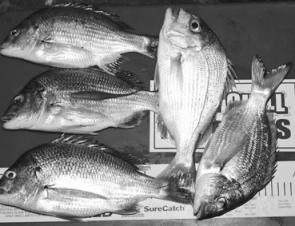What a great month of fishing we have experienced in the Northern Bay.
The winter species haven’t disappointed anglers with high expectations. Local headlands and inshore reefs have had plenty of fish activity with bumper sized bream the star attraction. Snapper fishing has lived up to last year’s numbers and some good quality fish are schooling up on the shallow grounds. The only thing stopping better catch numbers is the by-catch of bream – not that the 35cm bream should really be considered by-catch. In anyone’s books, catching snapper sized bream is every inshore anglers ideal fishing activity.
Other common species have been tailor, flathead, goldspot cod, whiting and the odd school jew. Most return trips to the boat ramps have resulted with excited anglers cleaning their catch in the cleaning stations, talking about their old favourite spots once and turning it on.
For those who may be unsure or new to the area this is a good place to start. Most anglers won’t tell you where they fish, or how they got their fish but a few leading questions will result in small amounts of information that can be useful. I always have a quick look around the cleaning stations as I launch my boat, to get an idea of what’s around and the sizes of the fish I can expect to encounter. Looking for fish scales and carcasses can help when there are no people to have a chat to. This way small adjustments can be made to terminal tackle such as hook size. It’s all about educating yourself, which will produce better than average results.
I am so excited about the bream fishery at the moment – I am always thinking about my next trip out to target these light tackle brutes. I talk to a lot of anglers who laugh at the idea of chasing bream, and I can understand the monotony of catching ‘just legal’ bream one after the other for a feed! I am talking about targeting large fish that put legal snapper to shame!
Flicking plastics over shallow reef, getting slammed, working the fish out of the structure and into open water takes some skill. Quite often these fish smash the lure as soon as it hits the water and explode on the surface, reminiscent of trevally.
Don’t be afraid at this time of the year to use plastics that you would expect to use for larger fish like snapper. Most of the anglers on TV use small, finesse plastics to conjure up nice fish, and this seems to be a direct link to people thinking that larger stickbaits won’t work on this fishery. These fish are hungry, and inhale 5” stickbaits easily. Most of the better bream have been boated with the whole lure lodged well and truly down their throat. This reward is testament to ‘thinking outside the box’.
By all means use small, light jigheads to allow for more ‘hang time’, but make sure that the hook size will allow for good penetration through the plastic. When breamin’ I prefer to use a Gamakatsu Darter 26, 1/4oz, with a 3/0 hook. This type of head does dart around when flicked as the name implies and creates plenty of attention. It also comes with a weed guard that helps in those shallow, fish-rich areas.
Stickbaits have been getting better results than paddle or curl tail grubs. The Berkley Gulp 5” Jerk Shad in darker colours like camo is my favourite. Light fluorocarbon leaders are a must to make the lure more presentable. Calm water is great fun to be fishing on but it also makes the fish flighty. Don’t be afraid to head out when there is a breeze ruffling the water, the fish respond much better to artificials when there is a bit of surface activity. This also lessens the chances of spooking fish from motor noise or the bangs and crashes that aluminium boats are prone to creating in a bit of chop.
The channel has always been a great spot to connect to pelagic species as well as reef dwellers. Over a few recent trips when the weather has allowed my 4.1m tinnie to get out, the fishing has been exceptional. Quite often this area is overlooked by larger boats heading out to the wide grounds and is also just out of reach for the smaller craft. Snapper season is a great time to try this area and often the fish that are pulled can be similar to those expected out further.
Finding locations in this area can be difficult, so the best way is to position yourself in a good flowing current line and drift until you encounter one of the many coffee rock reefs or drop-offs. Early morning has well been worth the effort to get out and try this area. Good catches of snapper, goldspot cod, parrot, coral trout and jew have come from this area over June and there are also school mackerel, tuna, and cobia that frequent this spot all year round. Good fresh baits of whiting or mullet fillet with minimal weight will make the trip worthwhile.
A recent trip in the middle of the day, for a couple of hours, on no particular tide was productive with a good haul of cod and snapper, which just shows what a bit of planning could produce next time. This area is a consistent spot to try all year round and the snapper are only going to get bigger over the next month.
Reads: 899
This is a common bag of bream and squire at the moment. The plastic used, a 5” Berkley Gulp, can be seen on the middle bream.

Scotty ‘Hotrocks’ with his gun performance first time out on the Bay with plastics, two great eating cod.




